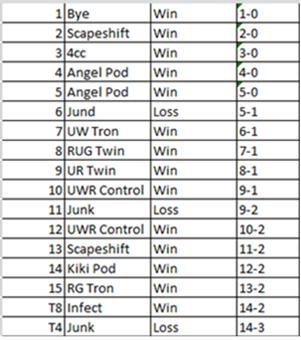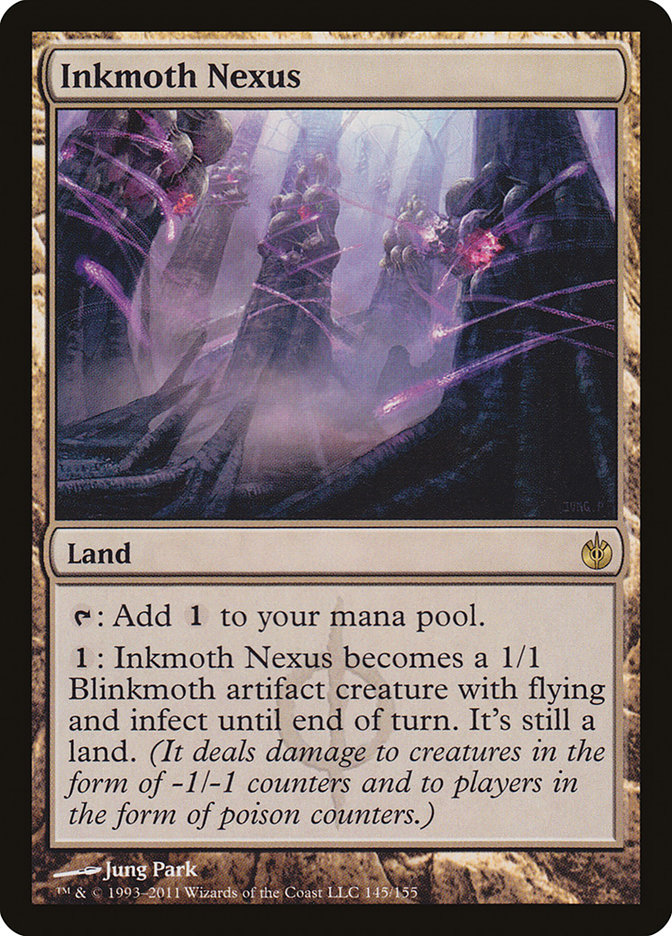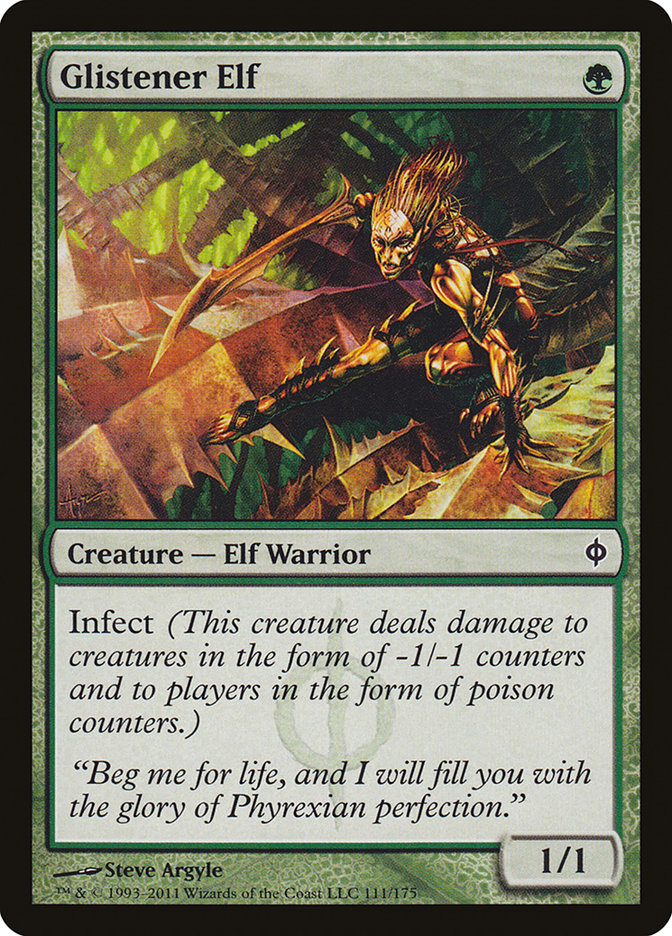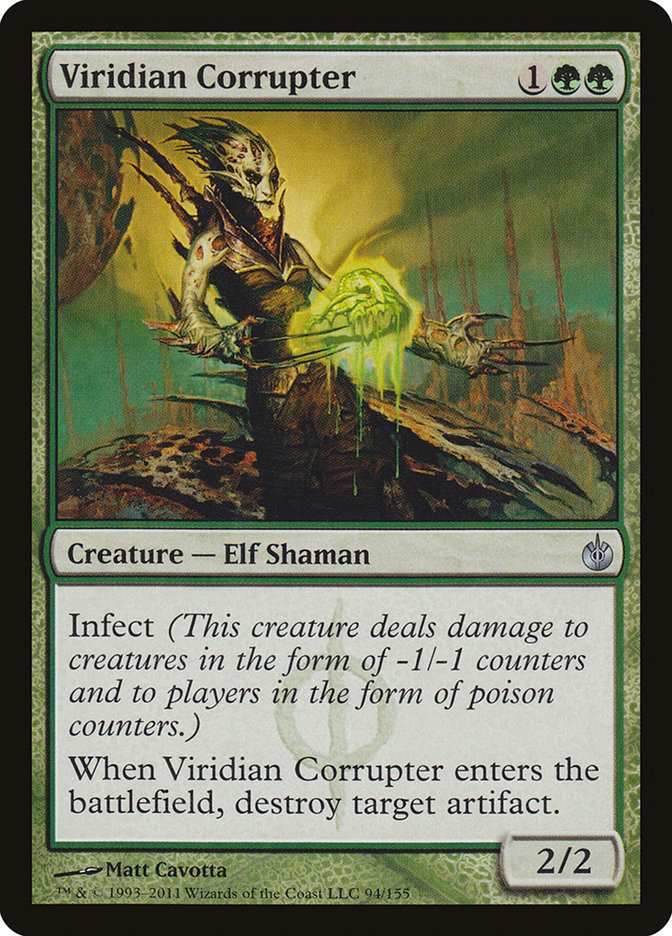“….and in seventh place……..Phil Napoli.”
Let me start out by saying that I’m a firm believer that all things in life, good or bad, happen for a reason.
I started playing Magic as a fledgling kid back in the good ole’ days of Revised (here’s looking at you, Scryb Sprites *wink*). After a
few years of beating up on my brother, both physically and with MTG cards, I happened upon a mythical place called Neutral Ground, where they played, of
all things…..COMPETITIVE MAGIC (Ooooh!!! Ahhhhh!!). And just like that I was hooked for life.
During my long competitive career I’ve enjoyed a moderate amount of PTQ success in the rough and tumble Northeast. That said, I always managed to crack
under pressure at the GP or PT level. Back then, I sported the full repertoire of bad habits. I used to tilt-off easily and constantly worried about
messing up while people watched me play (feature-match-punt-a-phobia). I’d often find myself thinking ahead to “I need x-more wins to T8,” or “I just need
to top-deck card Y,” when in reality, I had already missed the on-board win. I’d look down on lesser-skilled opponents and complain about being the least
lucky person alive. I was the typical MTG everyman – and now, fortunately, that’s become a thing of the past. As life progressed (I’m an elder statesman at
a ripe thirty-four years of age), I let go of all that unnecessary pressure and negativity swirling around in my brain. Nowadays, I view the game (and
life) through a much clearer lens. And just like that, just when I let go of the baggage and freed up that energy, it finally happened….and let me tell
you, boy does it feel nice!
I started this Modern season out playing Storm in the first two GPs. I was fairly happy with both my deck choice and my results, but I eventually came to
find that fighting a constant uphill battle against dedicated, crippling hate cards was far too difficult a load for my brain and my Wear/Tears to bare.
Around the same time as that epiphany, my partner in crime, Osyp, messaged me (probably on social media, if you know him #sickburn) that he was formally
replacing me as his best friend with none other than Tom Ross. Tom would fill Osyp’s head with tales of poisoning out his opponent, and my buddy was
completely entranced. Osyp eventually spilled Tom’s secrets and I quickly laughed him off. “You’ve definitely lost your touch, my friend.” Flash forward a
week and I find myself proxying up Infect and testing against myself on my bed (which I’ve been known to do from time to time). After taking between five
and ten test draws, I was on the phone willing to hear him out.
Tom’s list was very solid and well-tuned for his expected metagame. I personally wasn’t a fan of the Phytoburst, the fourth Viridian Corrupter, or the Pact
of Negation and was really high on Distortion Strike, Might of Old Krosa, and Apostle’s Blessing. Here’s the list I played:
Creatures (16)
Lands (21)
Spells (23)
- 3 Might of Old Krosa
- 4 Vines of Vastwood
- 4 Groundswell
- 3 Distortion Strike
- 4 Mutagenic Growth
- 1 Apostle's Blessing
- 3 Gitaxian Probe
- 1 Wild Defiance
Sideboard

We felt Tom’s original sideboard was pretty perfect, and given my result at the GP, I’d probably only change two cards total out of the 75.
I drove to the tournament with my other partner in crime, Jon Rubin, since Osyp was too busy cozying up to his new girlfriend this weekend. Jonny is too
funny during car rides and easily entertained me with his motor mouth and interesting views on life. Speaking of girlfriends, three weeks back, I met both
Jonny and Osyp’s current girlfriends at a birthday dinner held in Jonny’s honor. Apparently, both girls were petrified to meet me and referred to me as the
“end boss,” a title which I gladly accepted. They were obviously both great gals although I do have to question how these two jerks describe me if their
girlfriends were scared to meet me. Mmmmhmmm.
Here’s how my tournament went along with some highlights and lessons-learned:

R6 – Jund
: Game 1 was super grindy and featured my opponent, Mario Martinez, nerfing my infectors one by one, even using a maindeck Doom Blade to take out an
Inkmoth Nexus (arguably the best card in the matchup). As a rule, forcing your opponents to make plays on your turn is exactly where the Infect deck wants
to be, and Inkmoth Nexus consistently puts your opponent’s back up against that wall. Just when the coast looked clear for my opponent, I sacrificed a
stray Misty Rainforest on his end step, searching up Dryad Arbor, and handed him a lethal dose of fifteen damage using my stocked grip of pump spells.
Being willing to shift gears from poison to “actual damage” is something you should always be on the lookout for as you play this deck. This was just one
of many opponents who lost a game to a Dryad Arbor or Noble Hierarch. While I did win the first game in exciting fashion, I lost the match in a tight game
3 due to a blowout Golgari Charm, hitting my Inkmoth Nexus, Dryad Arbor, and Noble Hierarch.
Charming indeed.
R10 – UWR Control
: Sometimes you just have to go all-in. Look for clues, assess, make a read, and act accordingly. I decided to go for a turn 3 kill against my opponent’s
two open mana given three main factors (1) the longer the game goes, the harder it is for me to win (2) my hand was low on resilience (Vines of Vastwood,
Apostle’s Blessing) and was unlikely to get better given additional draw steps (3) the progression of lands and actions he took during the first two turns
indicated to me that he had neither Lightning Bolt nor Path to Exile (the most difficult card to beat in game 1). My read proved dead on, he had two
Lightning Helix, and I was able to protect my Glistener Elf with two pump spells for lethal. In game 2, Wild Defiance proved too good, blanking all
non-Path to Exile removal. I pulled off another damage kill here attacking with both a lethal infector and a lethal Noble Hierarch. He directed his
attention to my Blighted Agent, and Noble Hierarch quickly shut the door with a fourteen-point episode of roid rage.
R11 – Junk
: This round was against my buddy from New York, Ben Khazdan. Game 1, Ben had a timely Dismember to blow me out. In general you are about a 40/60 dog in
game 1. If Junk draws a Slaughter Pact or Dismember (to kill Inkmoth Nexus) that win-rate drops considerably lower. While it may feel unnatural against a
deck with a ton of sorceries, I often board one or two Dispel for games 2 and 3 just to prevent the aforementioned blowouts. Game 3 was a real nail-biter.
I had about six turns to rip a Distortion Strike to win with a Noble Hierarch (I was on the damage plan the whole game and knew Ben’s single card in hand
from an earlier Gitaxian Probe), but Ben fired first and closed me out with running Lingering Souls during that same top-decking window.
R14 – Kiki-Pod
: Round 14 saw me paired against my good friend and Jersey City neighbor, Anande Khare. Anande and I have known each other since way back in the TOGIT
days. Game 1 featured me needing a turn 3 kill (on the draw) to stop Anande’s turn 4 kill on the play. On my turn 3 I cast Distortion Strike on my Viridian
Corrupter and double pumped for the TKO. Anande unexpectedly blew me out in game 2 after I both attacked for five poison on turn 2 and killed his Birthing
Pod with Nature’s Claim, but sometimes the second Pod is all you need. In game 3, I returned the favor with a turn 2 Hunt the Hunter removing Anande’s
Birds of Paradise and robbing him of white mana for the remainder of the game, stranding two Path to Exile in his hand. A timely Nature’s Claim on Anande’s
desperation Spellskite sealed the deal. Beating a good friend stinks, but whatever….he’ll get over it.
R15 – GR Tron
: Ah, the dreaded “win and probably not in.” My opponent, Matt McCullough, was a great guy and a real good sport. My deck held true to form and outraced
him in a quick game 1. Game 2 saw Matt mulligan down to four cards. While shuffling, Matt regaled me with a tale of how he beat someone earlier in the GP
on a four card opener. It was fair to say I felt anything but comfortable. I played a turn 1 Noble Hierarch off a Forest and failed to drawn an infector or
second land for Viridian Corrupter for three turns. During this window, Matt naturals the Tron and slams down Karn (off four cards! NICE!). He’s faced with
a tough decision between my Noble Hierarch or my land and opts for the Hierarch. I respond with Vines of Vastwood and then attacked Karn and Mutagenic
Growth’d it to send him packing (nobody…and I mean NOBODY picks on my little druid). Matt was out of cards at this point, and I eventually drew an Inkmoth
Nexus to close out the game before Matt drew any significant action.
At this point, regular tournament math would have put me at about ninth or tenth on breakers, but given the Day 2 tiebreak reset, things were a bit more
unpredictable. That said, to be quite honest, I was so excited about my PT qualification that making Top 8 was almost irrelevant to me. It would be the
most unlikely icing on an otherwise perfect cake. I was packed up and ready to drive home (literally standing at the entrance of the hall) when they
announced six words that were music to my ears: “….and in seventh place……..Phil Napoli.” I’m honestly not sure who screamed louder, me or all my friends
combined. Within moments I flipped the switch from giddy to determined. If I was going to be tired going into work on Monday, I was going to make this
opportunity count.
T8
– Wes Havonec – Infect
Randy and Marshall’s coverage was pretty dead on in terms of what I was thinking. On the draw, my opening hand had a turn 3 kill unless Wes had a Vines of
Vastwood or killed me first. On his turn 3, Wes went for an attack which would only be lethal if he had two pump spells. Considering his list did not
contain Mutagenic Growth, and I was dead to a Groundswell whether I blocked or didn’t, I tanked for a while, played the odds, and decide to take the
attack. Wes pushed me up to seven poison counters and we moved on. On my next turn, I presented lethal on my Blighted Agent and fully expected Wes to have
the Vines of Vastwood to fizzle my Might of Old Krosa, which he did. I responded with double Mutagenic Growth, bringing Wes to eight poison. I left back
two blockers to match Wes’ three attackers. Based on his last turn and the mana he needed to activate Nexus, I knew Wes could only kill me with a topdecked
pump spell. I faded the draw, and attacked back for the unblockable win the following turn. Whew! Game 2 Wes blew me out with two disruption spells AND a
turn 3 kill, a true testament to the power level of the deck. Game 3 was another real nail-biter. I put myself into a position to (1) not die and (2) draw
a pump spell for the win…and that’s exactly what happened.
Lesson: Chance (sometimes) favors the prepared mind.
T4 – Robin Dolar – Junk
Wes summed it up best in his T8 profile when he said “Best Matchup: Decks that aren’t Junk. Worst Matchup: Junk.” Junk has all the removal of Jund + the
defense of Lingering Souls, which is pure hell for a deck trying to win with Inkmoth Nexus. This setup tends to rest your whole game plan on Distortion
Strike and Apostle’s Blessing. My hand in game 1 was pretty weak and failed to improve much over the first three turns, especially after Robin cast
Lingering Souls. I knew I’d have to play an unorthodox game to win. Robin swung in with a Goyf and two tokens, and I tried to off the Goyf with my Nexus +
two Mutagenic Growth. My intentions were good, but I lacked in my execution by sac-ing for a land (for no good reason) before blockers. If I hold off, I
can sac the land to Vines if he presents removal OR sac a land to grab Dryad Arbor should he go for Liliana post-combat. Having played incorrectly, Robin
punished me with said Liliana, and I drew the Dryad Arbor off the top the next turn as a cruel reminder of my momentary lapse of foresight. I played game 2
as well as I could, but a timely Engineered Explosives by Robin knocked off my two one-mana blockers and gave his Goyf the final point of power to knock me
out.
Having played sixteen rounds with the deck, I think the only changes I’d make are -2 Hunt the Hunter from the sideboard for +1 Dismember +1 Apostle’s
Blessing. While Hunt has blowout potential, it’s only “truly” a blowout if you lead with Glistener Elf. If I’m trying to reliably cripple my opponent’s
mana development, I want to be able to do so on my turn 1 if I’m on the draw, otherwise it’s too late. The two Twisted Image and one Dismember should be
enough to handle that scenario. As for the Apostle’s Blessing, I don’t expect Jund-ish removal and Lingering Souls to go away any time soon, and that’s
where you want to be against those cards.
I’m not a fan of sideboard guides, so here are a few tips/tricks and some key card interactions:
1. Vines of Vastwood can be used to fizzle the Deceiver combo and the opponent’s pump spells in the mirror.
2. Don’t sac your lands for no good reason – this will leave you with the option to search up Dryad Arbor and will leave you a potential landfall trigger
should you rip a Groundswell.
3. Might of Old Krosa is an instant (even though you cast it during your main phase) so you can respond to burn or an opposing Vines of Vastwood if need
be.
4. In matchups where Distortion Strike and Apostle’s Blessing are key, you can bring in Twisted Image to cantrip into those cards faster.
5. Twisted image is an excellent hedge against any deck that can potentially present Spellskite out of the board.
6. Don’t forget to exile your Distortion Strike when you cast it so you can rebound the following upkeep. You can activate and target your Inkmoth Nexus
with the rebounded Distortion Strike.
“Revised sideboard” recap:
Nature’s Claim: useful against Affinity, Tron, Pod and Twin (to varying degrees).
Twisted Image: useful against decks with mana dorks, Affinity, and to burn through your deck faster to hit matchup critical spells.
Apostle’s Blessing: useful against Jund-esque removal and to push through blockers.
Dismember: useful against the mirror and to kill mana dorks.
Spellskite: useful against decks with a lot of removal and against modular out of Affinity.
Dispel: useful, to varying degrees, against decks that fight with instants/counters.
Wild Defiance: useful against any deck that tries to fight largely with instant speed burn.
Overall, I was super proud of finally breaking through to a GP T8 and getting the monkey off my back! I remember a long, long time ago where T8ing a PTQ
felt nigh impossible. That was a hurdle I overcame and a major accomplishment that soon shifted to become an expectation. Here’s to hoping I can turn this
former impossibility into more of a regular thing.
See ya in Hawaii. You can find me in the Kapua Suite.



